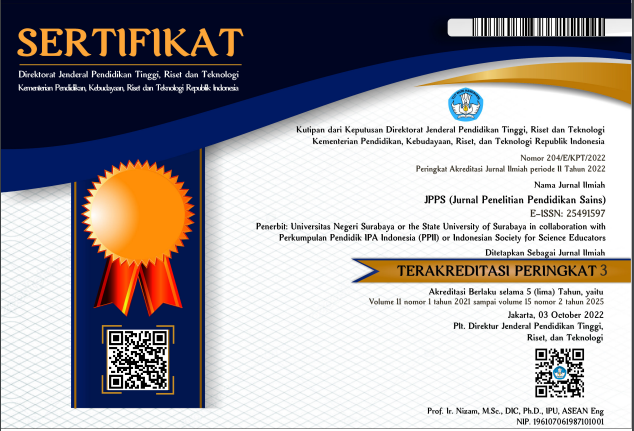PENGEMBANGAN PERANGKAT PEMBELAJARAN MODEL NESTEDBERBASIS INKUIRI TERBIMBING UNTUK MENINGKATKAN PEMAHAMAN KONSEP, THINKING SKILL, DAN SOCIAL SKILL PADA SISWA SMP
DOI:
https://doi.org/10.26740/jpps.v7n1.p1379-1385Keywords:
Nested, Guided Inquiry, Concept Understanding, Thinking Skill, Social SkillAbstract
This research was done by developing learning materials (lesson plans, students worksheets, textbooks students, test understanding of the concept, Thinking skill and Social Skill) nested models based guided inquiry by using 4D development model to improve the understanding of the concept, thinking skills and social skills on the subject of light. The objective of this research is trial learning materials for 32 of junior high schools students with the design of the one-group pretest-posttest design. Result was analyzed by descriptive quantitative - qualitative with: (a) validity of learning material is very valid category; (b) learning realization with good category; (c) the students response are positive; (d) students understanding of the concept is increased (high criteria); (e) thinking skill is increased (high criteria); (f) social skill increased in every meeting. In conclusions of this research, the nested model based learning guided inquiry concepts can improve the understanding concept, thinking skills, and social skill of junior high schoolDownloads
References
Arends, R. (2012). Learning to teach, 9th edition. New York: Mc-Graw Hill.
Branch, J. and Oberg, D. (2004). Focus on inquiry a teacher guide to implementing inquiry based learning. Canada: Alberta Education, Alberta.
Borich, G. D. (1994). Observation Skills for Effective Teaching. The University Of Texas: USA.
Depdiknas. (2003). Undang-undang Nomor 20 Tahun 2003 tentang Sistem Pendidikan Nasional. Jakarta: Pemerintah Republik Indonesia.
Gronlund, N. E.and Linn, R. L.(1995).Measurement and assesment in teaching(7th ed). New Jersey: Merril Englewood Cliffs.
Hake.(1999). Analyzing change/gain scores. (Online). Tersedia http://www.physicsindiana.edu/sdi/ Analyzing-Change-Gain. pdf.
Ibrahim, M. (2010). Dasar-dasar Proses Belajar Mengajar. Surabaya: Unesa Univesity Press.
Kemendikbud. (2015). Peraturan Menteri Pendidikan dan Kebudayaan Nomor 53 Tentang Penilaian Hasil Belajaroleh Pendidik dan Satuan Pendidik pada Pendidikan Dasar dan Pendidikan Menengah. Jakarta: Depdiknas
Levine & Ornstein. (1985). An introduction to The Foundations of Education. 3rd Edition. Boston: Houghton Mifflin Company.
Nur, M. (2012). Pengembangan Bahan Ajar untuk Memberi Kemudahan Guru
Mengimplementasikan Inovasi Pembelajaran. Surabaya: PSMS UNESA.
Ratumanan & Laurens. (2011). Penilaian Hasil Belajar pada Tingkat Satuan Pendidikan Edisi2. Surabaya: Unesa University Press.
Riduwan. (2010). Skala Pengukuran Variabel-Variabel Penelitian cetakan ke VII. Bandung: Alfabeta.
Sugiyono. (2013). Metode Penelitian Pendidikan Pendekatan Kuantitatif, Kualitatif dan R & D. Bandung: Alfabeta.
Thiagarajan, S., Semmel.D.S. & Semmel,M.I. (1974). Instructional Development for training teacher of Exceptional Children a Sourcebook.Bloomington: Center for Innovation on teaching the Handicape
Downloads
Published
How to Cite
Issue
Section
 Abstract views: 358
,
Abstract views: 358
, PDF Downloads: 464
PDF Downloads: 464













